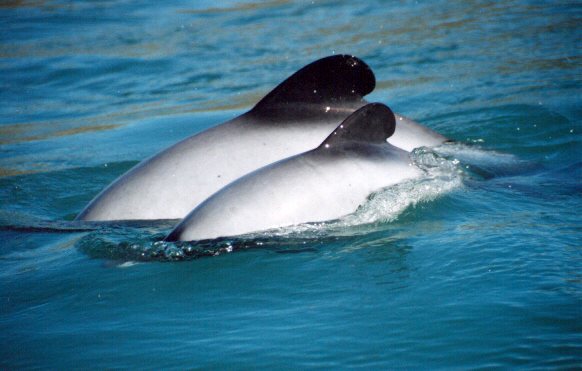Swimming with dolphins in New Zealand:
A multi-species research example
Abstract
The swim-with-dolphin industry was established in New Zealand in 1989.
It is managed by the Department of Conservation under a permitting
system designed to control the level of commercial marine mammal based
tourism. Swimming with dolphins is allowed, but it is illegal to
harass or disturb dolphins, or to swim with groups containing juveniles.
In 1997, there were almost 60 commercial operations taking people out
to swim with primarily dusky, Hector's, bottlenose, and common dolphins.
Our research focused on bottlenose and common dolphins in the Bay
of Islands (RC), Hector's dolphins in Porpoise Bay (LB), and dusky
dolphins in Kaikoura (SY). We used both land- and boat-based methods
to study the effects of the swim-with-dolphin industry. Land-based research
using a theodolite is a non-invasive technique allowing for accurate
measures of boat and dolphin speed and direction. It is ideal for
data collection on large groups (up to several hundred dolphins)
and on group behavior. However, theodolite studies do not allow for detailed
behavioral observations on an individual level. To date, boat-based
studies on impacts of swim-with-dolphins have concentrated on detailed
group behavior, but data on individual dolphin behavior can also
be collected. Unfortunately, boat-based studies can be invasive and
do not allow for measurement of avoidance reactions to boats at distances.
In New Zealand, boats are most often the platform from which swim-with-dolphin
operations take place. It is therefore important to also consider
boating impacts when evaluating the overall effects of swim-with-dolphin
operations.
R. Constantine began boat-based MSc research on the bottlenose and
common dolphins in the Bay of Islands in 1994, and is currently completing
a PhD on the bottlenose dolphins. Results from 1994-95 showed dolphin
response to swimmers was affected by swimmer placement from the commercial
vessels. Common dolphins were less likely to interact with, and more
likely to avoid swimmers than bottlenose dolphins (24% vs 48% interaction,
and 38% vs 22% avoidance). Recent results from research on bottlenose
dolphins comparing data from 1994-95 to 1997-98, have shown a significant
decrease in the success of swims, and an overall increase in avoidance
responses to swimmers. Photo-identification has shown an 82% resight
rate of bottlenose dolphins in the Bay. These dolphins are not resident
in the Bay but have had a number of exposures to swim attempts over
the past six years and therefore it is likely that this population
has become sensitised to swim-with-dolphin tours.
S. Yin conducted theodolite and boat-based acoustic research on dusky
dolphins in Kaikoura from 1994-1997 for her MSc. Results on the effects
of boat presence on small groups (<25) of dolphins peripheral
to the main group, suggested that the presence of the tourist vessels
had not changed the overall mean speeds since Cipriano and Wursig's pre-tourism
research in the 1980's. Caution is necessary as there was a great deal
of variation in mean leg speed recorded within and between groups of animals
which suggests that this variable may not have been an adequate measure
of disturbance. Linearity of groups was higher with boat and post boat
conditions which suggests dolphins may meander more and move in a less
directed manner when no boats are nearby. The linearity and reorientation
rates both revealed slight differences between no boat and boat condition.
L. Bejder conducted land-based theodolite observations to quantify Hector's
dolphin group reactions to boats and swimmers in Porpoise Bay from 1995-1997. 
The commercial dolphin-watching operation in Porpoise Bay does
not offer swim-with-dolphin encounters. Instead, non-commercial swim-with-dolphin
attempts occur off the beach. Dolphins were accompanied by swimmers
(within 200m) for 11.2% of the total observation time (251 hours),
whereas boats accounted for an additional 12.4%. Analyses of relative
orientation indicated that dolphins tended to approach the dolphin-watching
boat in the initial stages of an encounter, but became less interested
as the encounter progressed. By 70 minutes into an encounter, dolphins
were either actively avoiding the boat or equivocal towards it. Dolphin
groups were significantly more tightly bunched when a boat was present
in the bay. Forty two percent of swim-with-dolphin attempts were classified
as at least potentially disturbing (dolphins left the 200m vicinity of
swimmer entry either immediately or within 5 minutes of swimmer entry).
There are a number of practical limitations when conducting research
on the effects of swimming with dolphins (e.g. geographical limitations
of research site, temporal variations in habitat use of study animals).
Furthermore, the duration of data collection is often compromised by time
constrains set forth by management committees. Research designs should
incorporate methods of data collection that allow for rapid detection/indication
of possible impacts. The short term focus should be incorporated
into a long term research plan that emphasises long term cumulative
impacts. Management recommendations based on short term research
should be highly precautionary.
Currently, only the dusky dolphin population of Kaikoura have received
detailed study before being targeted by commercial operations. Unfortunately
for all other species and populations currently exposed to tourism,
"before and after" comparisons are impossible. Research designs must
account for the level of tourism established and the feasibility
of collecting control data, the latter is often difficult to achieve.
Future research designs should, where possible, strive to include
focal individual observations and multiple data collection strategies
to assess impacts. Simultaneous data collection of acoustic and behavioural
reactions (on a group and individual level) will allow for a more complete
assessment of impacts. Furthermore, a more comprehensive approach
will highlight how data collection methods can affect conclusions
about impacts on dolphins and thereby also management recommendations.
